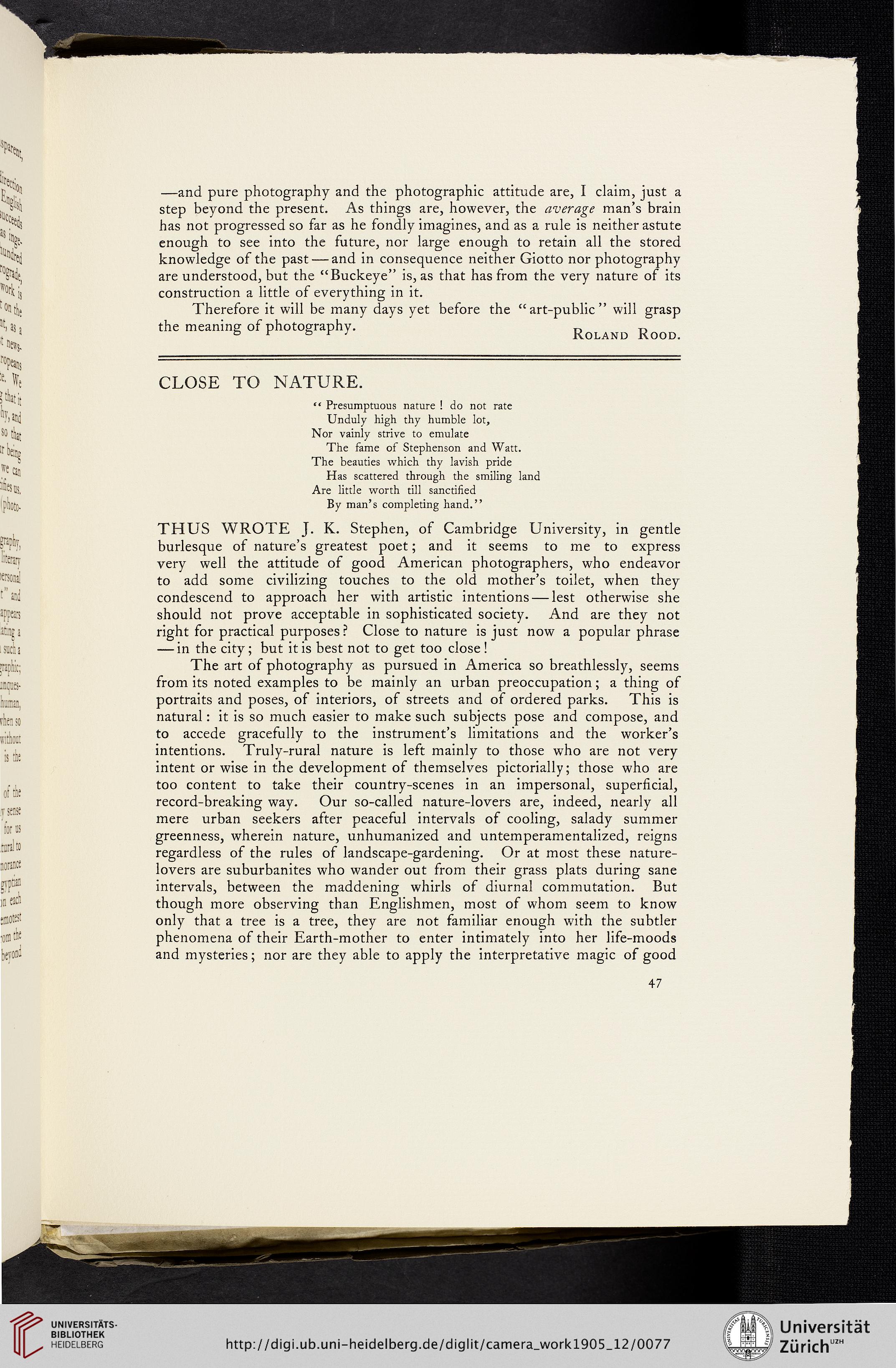Für diese Seite ist auch eine manuell angefertigte Transkription bzw. Edition verfügbar. Bitte wechseln Sie dafür zum Reiter "Transkription" oder "Edition".
—and pure photography and the photographic attitude are, I claim, just a
step beyond the present. As things are, however, the average man’sbrain
has not progressed so far as he fondly imagines, and as a rule is neither astute
enough to see into the future, nor large enough to retain all the stored
knowledge of the past — and in consequence neither Giotto nor photography
are understood, but the “Buckeye” is, as that has from the very nature of its
construction a little of everything in it.
Therefore it will be many days yet before the “ art-public ” will grasp
the meaning of photography. Roland Rood.
CLOSE TO NATURE.
“ Presumptuous nature ! do not rate
Unduly high thy humble lot,
Nor vainly strive to emulate
The fame of Stephenson and Watt.
The beauties which thy lavish pride
Has scattered through the smiling land
Are little worth till sanctified
By man’s completing hand.”
THUS WROTE J. K. Stephen, of Cambridge University, in gentle
burlesque of nature’s greatest poet; and it seems to me to express
very well the attitude of good American photographers, who endeavor
to add some civilizing touches to the old mother's toilet, when they
condescend to approach her with artistic intentions — lest otherwise she
should not prove acceptable in sophisticated society. And are they not
right for practical purposes ? Close to nature is just now a popular phrase
— in the city; but it is best not to get too close !
The art of photography as pursued in America so breathlessly, seems
from its noted examples to be mainly an urban preoccupation; a thing of
portraits and poses, of interiors, of streets and of ordered parks. This is
natural: it is so much easier to make such subjects pose and compose, and
to accede gracefully to the instrument's limitations and the worker's
intentions. Truly-rural nature is left mainly to those who are not very
intent or wise in the development of themselves pictorially; those who are
too content to take their country-scenes in an impersonal, superficial,
record-breaking way. Our so-called nature-lovers are, indeed, nearly all
mere urban seekers after peaceful intervals of cooling, salady summer
greenness, wherein nature, unhumanized and untemperamentalized, reigns
regardless of the rules of landscape-gardening. Or at most these nature-
lovers are suburbanites who wander out from their grass plats during sane
intervals, between the maddening whirls of diurnal commutation. But
though more observing than Englishmen, most of whom seem to know
only that a tree is a tree, they are not familiar enough with the subtler
phenomena of their Earth-mother to enter intimately into her life-moods
and mysteries; nor are they able to apply the interpretative magic of good
step beyond the present. As things are, however, the average man’sbrain
has not progressed so far as he fondly imagines, and as a rule is neither astute
enough to see into the future, nor large enough to retain all the stored
knowledge of the past — and in consequence neither Giotto nor photography
are understood, but the “Buckeye” is, as that has from the very nature of its
construction a little of everything in it.
Therefore it will be many days yet before the “ art-public ” will grasp
the meaning of photography. Roland Rood.
CLOSE TO NATURE.
“ Presumptuous nature ! do not rate
Unduly high thy humble lot,
Nor vainly strive to emulate
The fame of Stephenson and Watt.
The beauties which thy lavish pride
Has scattered through the smiling land
Are little worth till sanctified
By man’s completing hand.”
THUS WROTE J. K. Stephen, of Cambridge University, in gentle
burlesque of nature’s greatest poet; and it seems to me to express
very well the attitude of good American photographers, who endeavor
to add some civilizing touches to the old mother's toilet, when they
condescend to approach her with artistic intentions — lest otherwise she
should not prove acceptable in sophisticated society. And are they not
right for practical purposes ? Close to nature is just now a popular phrase
— in the city; but it is best not to get too close !
The art of photography as pursued in America so breathlessly, seems
from its noted examples to be mainly an urban preoccupation; a thing of
portraits and poses, of interiors, of streets and of ordered parks. This is
natural: it is so much easier to make such subjects pose and compose, and
to accede gracefully to the instrument's limitations and the worker's
intentions. Truly-rural nature is left mainly to those who are not very
intent or wise in the development of themselves pictorially; those who are
too content to take their country-scenes in an impersonal, superficial,
record-breaking way. Our so-called nature-lovers are, indeed, nearly all
mere urban seekers after peaceful intervals of cooling, salady summer
greenness, wherein nature, unhumanized and untemperamentalized, reigns
regardless of the rules of landscape-gardening. Or at most these nature-
lovers are suburbanites who wander out from their grass plats during sane
intervals, between the maddening whirls of diurnal commutation. But
though more observing than Englishmen, most of whom seem to know
only that a tree is a tree, they are not familiar enough with the subtler
phenomena of their Earth-mother to enter intimately into her life-moods
and mysteries; nor are they able to apply the interpretative magic of good


